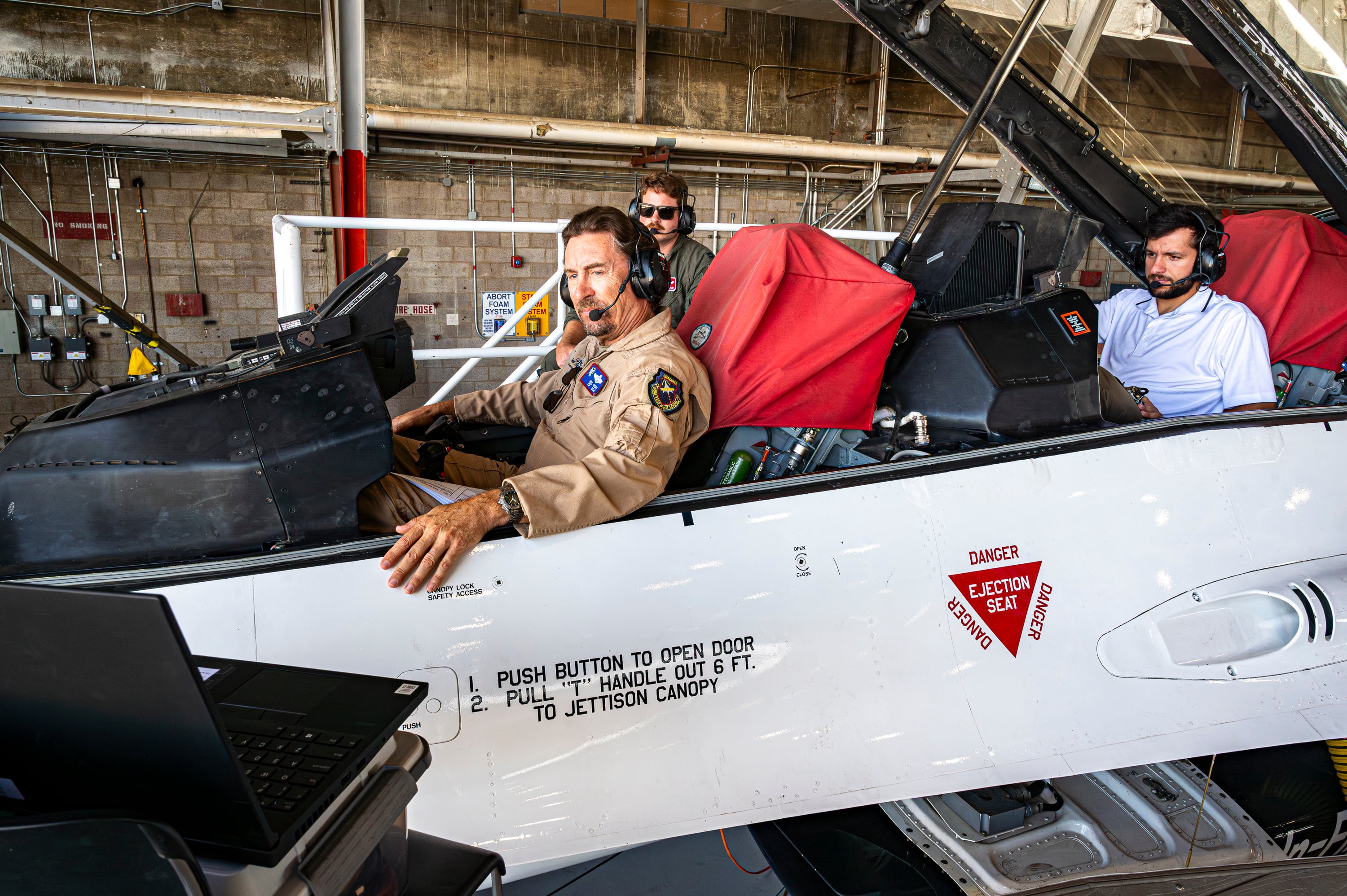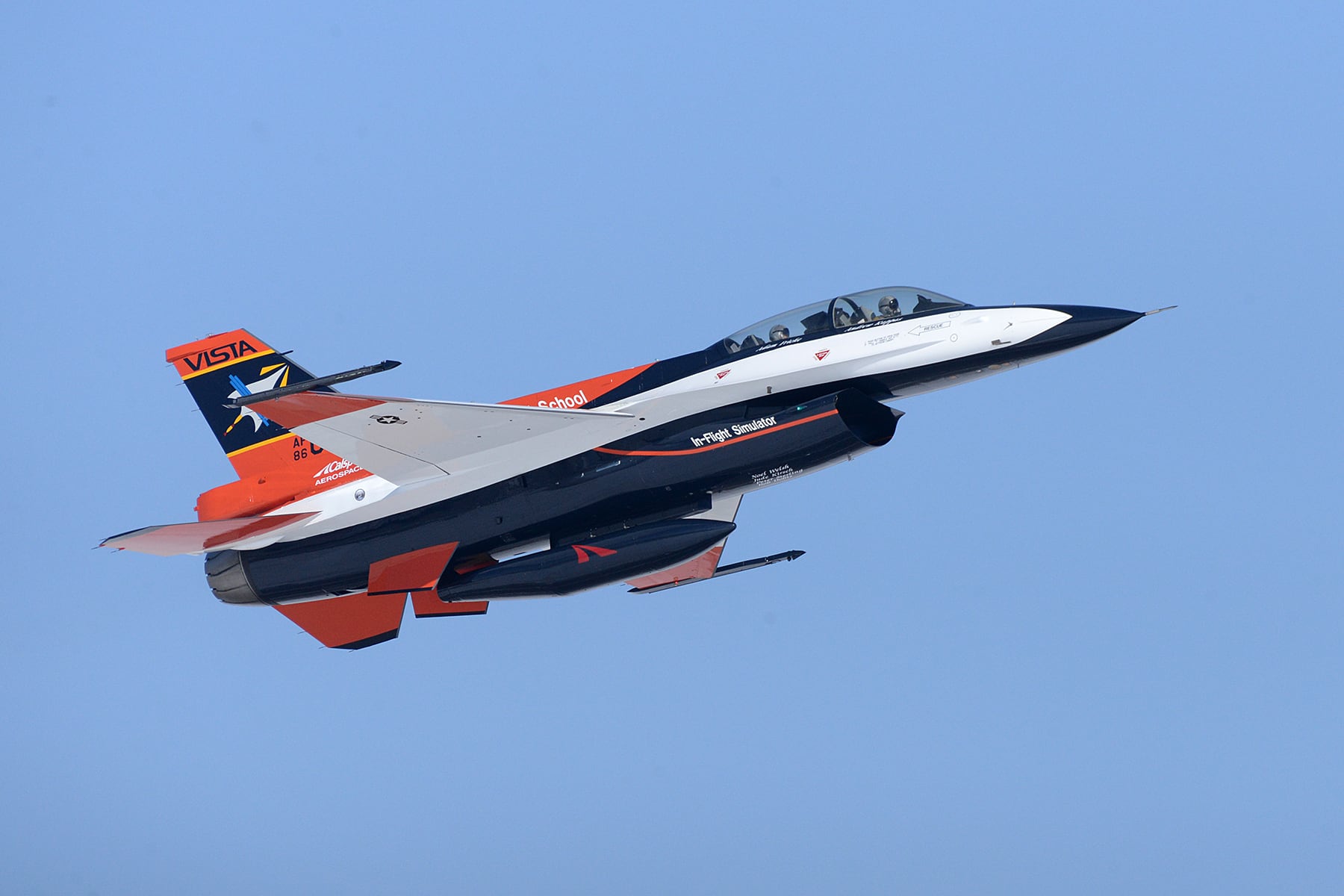An experimental fighter jet has squared off against an F-16 in the first-ever artificial intelligence-fueled dogfights, the Air Force and the Defense Advanced Research Projects Agency said.
And the successful effort to have the X-62A VISTA engage in practice aerial combat could help the Air Force further refine its plans for autonomous drone wingmen known as collaborative combat aircraft, officials told reporters Friday.
VISTA, which stands for Variable In-flight Simulator Aircraft, is a heavily modified F-16 operated by the U.S. Air Force Test Pilot School at Edwards Air Force Base in California. The service has used it to test cutting-edge aerospace technology for more than three decades, and in recent years it’s been used to test autonomous flight capabilities.
DARPA’s Air Combat Evolution, or ACE, program has been working for the last four years to refine how the military can use AI for air warfare and build airmen’s trust that autonomous technology can perform safely and reliably in combat.
Until now, the military has used autonomy for aspects of flight that are predictable and based on a set of known rules, such as the Auto Ground Collision Avoidance System that keeps jets such as the F-35 from crashing. But within-visual range dogfighting — perhaps the most dangerous, unpredictable form of flight a pilot can engage in — represented an entirely different set of skills for AI to learn, said Col. James Valpiani, commandant of the Air Force Test Pilot School.
“Dogfighting presents a very important challenge case for the question of trust” in autonomy, Valpiani said. “It’s inherently very dangerous. It’s one of the most difficult competencies that military aviators must master.”
The ACE program started by having AI agents control simulated F-16s while dogfighting in computers. Those AI-operated simulated F-16s went five for five against human pilots, DARPA said in a video posted online. But they weren’t yet trained to follow safety guidelines — including those that keep a pilot from breaking the jet — and other ethical requirements such as combat training rules and weapons engagement zones.
In December 2022 and April 2023, the Air Force and DARPA started actual flight tests with AI agents flying VISTA. And in September 2023, it was time for VISTA to go toe-to-toe with a human pilot.
For two weeks, VISTA flew against an F-16 in a variety of scenarios, including situations where it started at a disadvantage against the human-flown jet. VISTA started off by flying defensively to build up confidence in its flight safety, before switching to intense offensive maneuvers. Valpiani said the jets flew aggressively at speeds of up to 1,200 miles per hour and within 2,000 feet of one another, including carrying out nose-to-nose passes and vertical maneuvering.

Two pilots were in VISTA’s cockpit to monitor its systems and switch between different AI agents to test their performance, but they never had to take over flying. VISTA carried out 21 test flights between December 2022 and September 2023.
Lt. Col. Ryan Hefron, DARPA’s ACE program manager, and Valpiani said the AI-flown VISTA performed well and tested a variety of agents with multiple different capabilities. But they declined to say how many times VISTA beat the human-flown F-16.
“The purpose of the test was to demonstrate we can safely test these AI agents in a safety-critical air combat environment,” Hefron said.
Hefron and Valpiani said the ACE program learned multiple lessons from the dogfighting tests, including how to quickly adapt AI software and upload it to the jet, sometime while already in flight.
Hefron said the program next plans to hold more VISTA-versus-F-16 matches to refine the technology and test out different scenarios.
They declined to say whether the ACE program’s dogfighting effort might one day lead to a future fighter fleet without pilots in the cockpit, saying those “long range vision” questions are better suited for Air Force leadership. But Valpiani noted that developments such as Auto-GCAS haven’t replaced pilots’ need to be continually aware of their terrain, and only serve as a backup failsafe.
And the lessons learned from ACE could apply to more than just dogfighting, they said. ACE will allow the service to create uncrewed CCAs that can autonomously fly alongside crewed fighters such as F-35s and the Next-Generation Air Dominance platform, carrying out missions such as airstrikes and reconnaissance operations.
“The X-62A program and DARPA’s ACE program are not primarily about dogfighting,” Hefron said. “They’re really about building trust in responsible AI. The key takeaway from our September event is that we can do that safely, we can do it effectively.”
Air Force Secretary Frank Kendall is confident enough in the ACE program’s progress that he plans to soon fly as a passenger in the AI-operated VISTA. DARPA and the Air Force declined to say more specifically when Kendall will fly in VISTA.
“There will be a pilot with me who will just be watching, as I will be, as the autonomous technology works,” Kendall told senators during a budget hearing April 9. “Hopefully neither he or I will be needed to fly the airplane.”
Stephen Losey is the air warfare reporter for Defense News. He previously covered leadership and personnel issues at Air Force Times, and the Pentagon, special operations and air warfare at Military.com. He has traveled to the Middle East to cover U.S. Air Force operations.







